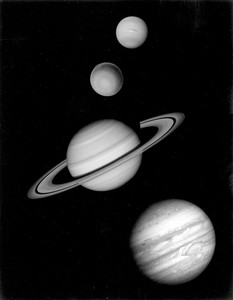Two US probes to the outer planets. Voyager 1, which was launched after Voyager 2 but on a faster trajectory, visited Jupiter and then Saturn, passing close to Saturn’s largest satellite, Titan. Its trajectory was swung out of the ecliptic by the Saturn encounter, so that it could not reach other planets. Voyager 2’s course took it on to Uranus and then Neptune, giving the first close-up views of these remote worlds, their satellites, and rings. Both Voyagers are now on trajectories that will take them out of the Solar System. In 2012 August, 35 years after its launch, Voyager 1 passed through the heliopause, the boundary of the region within which the solar wind flows, thereby becoming the first man-made object to enter interstellar space.
Voyager Probes
Probe
Launch date
Results
Voyager 1
1977 September 5
Jupiter fly-by 1979 March 5; Saturn fly-by 1980 November 12
Voyager 2
1977 August 20
Jupiter fly-by 1979 July 9; Saturn fly-by 1981 August 26; Uranus fly-by 1986 January 24; Neptune fly-by 1989 August 25.
http://voyager.jpl.nasa.gov/ Official mission website.
Either of two US space probes. Voyager 1, launched on 5 September 1977, passed the planet Jupiter in March 1979, and reached Saturn in November 1980. Voyager 2 was launched earlier, on 20 August 1977, on a slower trajectory that took it past Jupiter in July 1979, Saturn in August 1981, Uranus in January 1986, and Neptune in August 1989. Like the Pioneer probes, the Voyagers are on their way out of the Solar System.
The Voyagers are currently the only operational probes at or near the edge of interstellar space. Their tasks include helping scientists to locate the heliopause, the boundary at which the influence of the Sun gives way to the forces exerted by other stars. The probes are still sending back measurements from their lowest-power instruments, such as the magnetometers and particle detectors. Both Voyager probes have only 69.63 kilobytes of total memory, but the crafts are programmed to write over old data once it is transmitted back to Earth.
Both Voyagers also carry coded recordings called ‘Sounds of Earth’, intended to enlighten any other civilizations that might find them.
Voyager 2 was not intended to visit Uranus and Neptune, but scientists were able to reprogram its computer to take it past those planets. Voyager 2 passed by Neptune at an altitude of 4 800 km, and its radio signals took 4 hours 6 minutes to reach Earth.
In December 2017, Voyager 1 fired a pair of thrusters for the first time in 37 years, from a distance of over 20 billion kilometres from Earth.

Photo montage of the gas giants from the Voyager 'grand tour'. Bottom to top, with increasing distance from the inner Solar System, are Jupiter, Saturn, Uranus, and Neptune.
Credit: NASA
Two NASA spacecraft that were launched in 1977 (Voyager 1 on 5 September and Voyager 2 on 20 August) on a mission to Jupiter, Saturn, Uranus, Neptune, and out of the solar system. Voyager 1 passed Jupiter in March 1979 and Saturn in November 1980, its camera being used for the last time on 13 February 1990, to take pictures of the entire solar system, except for Mars, Mercury, and Pluto; Voyager 2 reached Jupiter in July 1979 and Saturn in August 1981. They completed their explorations in 1989, but continued on their way. By 2018 Voyager 1 had entered interstellar space and Voyager 2 was in the heliosheath, the outermost layer of the heliosphere, where the pressure from interstellar gas slows the solar wind.
http://voyager.jpl.nasa.gov/ A NASA programme of two missions launched in 1977 to study the planetary systems of Jupiter and Saturn and beyond.
- origin of elements
- origin of life
- origin principle of taxation
- Origins Program
- Origins, Spectral Interpretation, Resource Identification, Security-Regolith Explorer
- O-ring
- Orion
- Orion Arm
- Orion Association
- Orionid meteors
- Orion Molecular Clouds
- Orion Nebula
- Orion spacecraft
- Orion Spur
- Orion variable
- Oriskanyan
- Orlando, Vittorio Emanuele (1860–1952)
- Orléans, Duc d’
- ORM
- ornithine
- ornithine cycle
- Ornithischia
- ornithischian dinosaur
- ornithomimid
- Ornithopoda